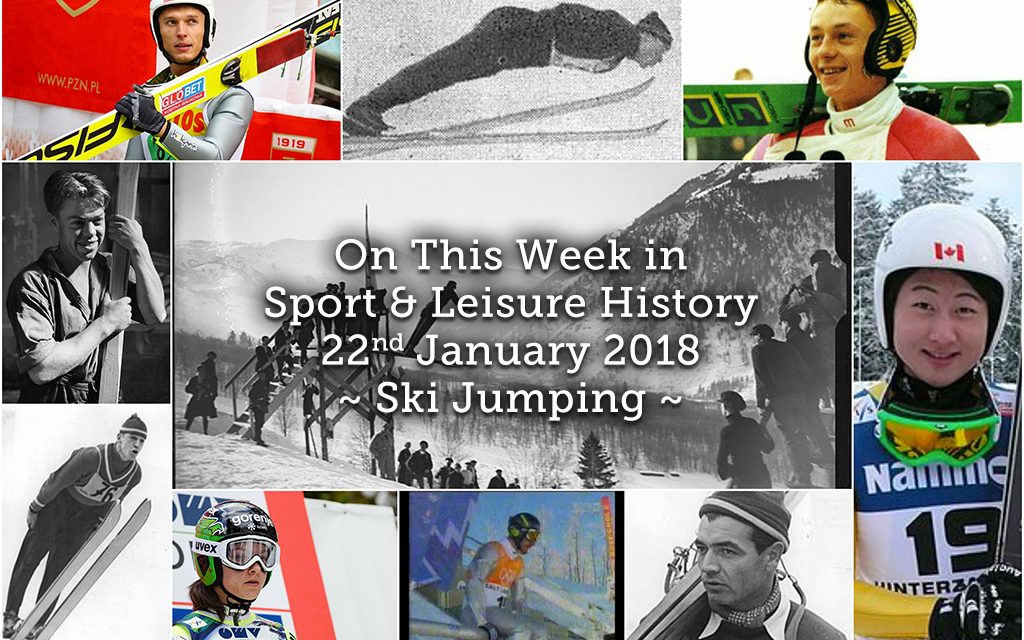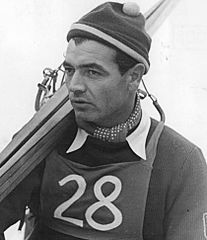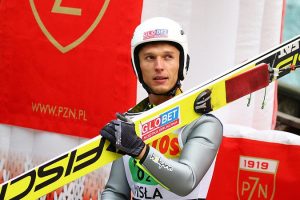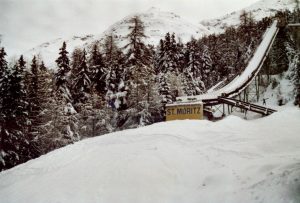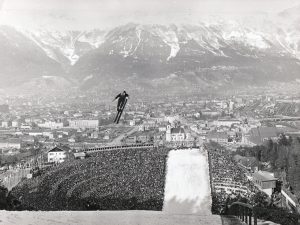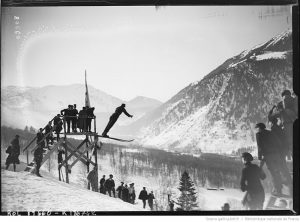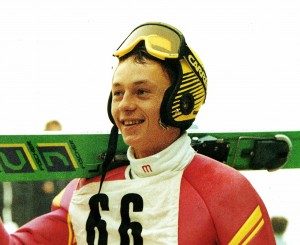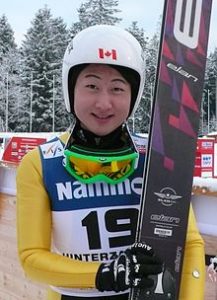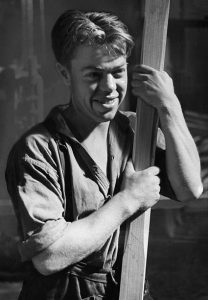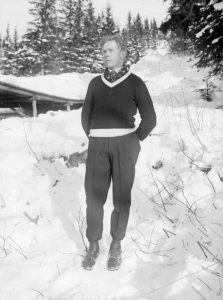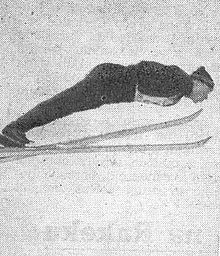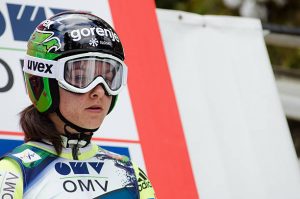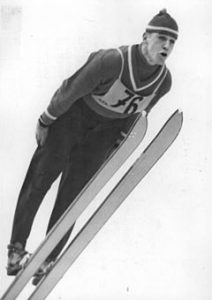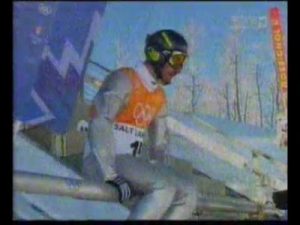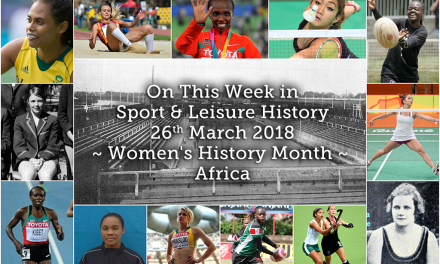22nd–Josef Sepp Weiler, who was born on this day in 1921 in Oberstdorf and died on 24th May 1997, was a German ski jumper who made his national debut in 1937 on the Holmenkollen in Oslo. In 1938, he took part in the World Ski Championships in Lahti, finishing 29th. During World War II he served in the German army in the USSR, he was severely wounded and blinded in his left eye. Despite this handicap he managed to win 35 of 36 ski jumping competitions in the 1948-49 season. At the 1952 Oslo Winter Olympics he finished 8th. Four years later he was a member of the German National team for the Winter Games at Cortina d’Ampezzo , but returned home before the competition, when his mother died. Weiler also took part in the first edition of the Four Hills Tournament in 1953, in which he came 5th, he also took part in this event in the 1953/1954 and 1955/1956 seasons. Weiler, along with two other skiers from Oberstdorf, Heini Klopfere and Toni Brutscher, took the initiative to build a ski jumping hill in Oberstdorf. The first competition on the new facility took place in 1950. Weiler was the first winner of the International Week of Ski Flights. He was also one of the three jumpers who set a world record in the length of the flight during this competition. His record-breaking jump took place on 2nd March 1950, with a distance of 127m. In 1952, for the second time he won the Week of Ski Flights, winning this event ex aequo with Hans Bjørnstad, Sepp Weiler is the grandfather of another German ski jumper, Frank Löffler and was a trained plumber, in later life he owned a pub at the Heini-Klopfer-Skiflugschanze (Flying Hill) until his death due to cancer. He was awarded the Silver Bay Leaf in 1952 by then German president Theodor Heuss.
Born today in 1923 in Maaninka, Olavi Kuronen, Finnish ski jumper who competed in the 1950s. He finished tied for 12th in the individual large hill event at the 1952 Winter Olympics in Oslo and died on 8th January 1989 at the age of 65.
Multi winter sport discipline athlete, Swedish Bengt Eriksson was born in 1931. With his silver medal at the 1956 Olympic Winter Games,Eriksson is still considered the most successful Swedish athlete in Nordic combined Prior to the Olympics, Eriksson became Swedish champion in the Nordic combined for the first time in 1953. His eighth and He made his international debut at the 1954 World Championships at home in Falun. In 1956 he won the Swedish Ski Games and competed at the Holmenkollen Games 11 times, winning 19 awards, including a second place in the combined competition in 1958. For four consecutive years, 1957-60, he was the best combination jumper at Holmenkollen taking the Damenes Trophy the first three times, presented at that time to the competitor who managed to win the ski jumping portion of the combined event. In 1960, the trophy was not awarded.Eriksson was also a very successful ski jumper winning Swedish Championships in 1958 and 1960 on the normal hill. In the same year, he competed in the Nordic combined as well as ski jumping at the Winter Olympics in Squaw Valley, where he was placed 19th in jumping and 10th in Nordic combined. Starting in the 1961-62 season Eriksson competed in the Four Hills Tournament in Austria and Germany for two years without major success. In 1965 he received the Holmenkollen Medal for his achievements together with Arne Larsen from Norway and Arto Tiainen from Finland although he never managed to win an event there. He made his last appearance in the World Championships at Oslo in 1966. Eriksson also played football successfully for many years. He died on 19th November 2014.
Martin Koch, Austrian ski jumper, was born today in 1982. He started his World Cup career in 1999 and finished in the top 3 in all ski jumping events eighteen times. This included two victories with the first being on 8th January 2011 in Harrachov. He also won a silver medal at the 2008 Ski Flying World Championships and six gold medals in team events at the 2006 Winter Olympics and World Championships. He made his last World Cup jump in March 2013 on the large hill in Planica. Regarded as a ski flying specialist,Koch held the Austrian national distance record with a jump of 241.5m in Vikersund in 2011, until this was beaten by countryman Gregor Schlierenzauer in the same event.Koch is the nephew of ski jumpers Armin Kogler and son of Fritz Koch.
Polish ski jumper Łukasz Rutkowski, born in 1988 in Zakopane and has an older brother Mateusz, also a ski jumper. He made his Continental Cup debut in February 2006, his best result being a sixth place from Vikersund in March 2008. He also finished seventh in the normal hill at both the 2006 and 2008 Junior World Championships; at the latter event he also won a bronze medal in the team competition. He made his World Cup debut in January 2008 in Zakopane, and collected his first World Cup points with a 27th place in December 2008 in Engelberg. His best result is a 24th place in January 2009 in Zakopane. At the FIS Nordic World Ski Championships 2009 in Liberec, he finished fourth in the team large hill event. He finished sixth in the team large hill event at the 2010 Winter Olympics in Vancouver.
- Josef Sepp Weiler
- Łukasz Rutkowski
23rd
Anton Wieser also known as Toni Wieser was born on this day in 1921 in Bischofshofen, he died on 30thJanuary 30,1993. Wieser started ski jumping in the mid-1930s. Due to the Second World War , his still young career, in which he had already achieved some success in youth competitions, was interrupted. After the war, he continued his athletic career and in 1946 was the Salzburg national champion. In the next few years he reached several podium finishes at international FIS competitions. In the winter of 1946/47 he jumped to third place on the large hill in Bischofshofen and the following season he scored two second places on the large hill in Bischofshofen and on the normal hill in Zell am See as well as three other top-5 results. He also was part of the Austrian team for the 1948 Winter Olympics in St. Moritz , where he finished 28th on the normal hill – the third-best Austrian.. In the1949/50 season he came in seventh place on the large hill in Ponte di Legno and 1952/53 saw him reaching seventh place on the normal hill in Celje and eighth on the normal hill in Marburg his last international top-10 result. After his active career he took over the coaching and training of the Austrian Ski Association youth team between 1965 and 1972. In 1972 he received the ÖSV for his services to the Austrian ski jumping.
Aleksandr Ivannikov, born in Moscow in 1945, was a Soviet ski jumper who competed from 1963 to 1972. He finished sixth in the individual large hill event at the 1964 Winter Olympics in Innsbruck and 17th in the individual normal hill. His best career finish was second in an individual normal hill event in Austria in 1964.
Vasyl Vasylovych Hrybovych born on this day in Ukraine in 1970, took part in the 1994 Lillehammer Winter Olympics in both the individual normal and large hill events, placing 56th and 52nd respectively.
- Olympic Ski jump at St Moritz
- A ski jumper at Innsbruck 1964
24th-Josef Bim was born in the Czech Republic on this day in 1901. At the 1924 Winter Olympics, he competed quite successfully, particularly in the military ski patrol, finishing fourth with the Czechoslovakian team. At the 1925 World Championships he finished eighth in ski jumping and an excellent fifth in Nordic combined. The following year he dropped to 23rd place in Nordic combined and did not finish the jumping event. At his second Olympic appearance in 1928, he competed only in ski jumping where he came 20th. At home, Bim won national titles in Nordic combined (1921) and jumping (1929). He died prematurely aged 33 on 5th September 1934. The military ski patrol was held only at the 1924 Olympic Winter Games as an official competition, although it was a demonstration sport in 1928, 1936, and 1948. For many years it was considered a demonstration sport in 1924, as well, but more recent research by Ture Widlund, co-founder and the first Vice-President of the International Society of Olympic Historians (ISOH), showed that both curling and military ski patrol had the same status in 1924 as all the other sports on the Winter Programme. After the IOC was contacted concerning this discovery, these events were restored to full medal status by the IOC shortly before the 2006 Olympic Winter Games. A similar event to the military ski patrol was the team event contested at Biathlon World Championships between 1989 and 1998.
- Josef Bim at 1924 Olympics in Chamonix
25th-Mario Bonomo, born in Asiago, Italy today in 1912, was affiliated to the Sport Union Asiago Ski club. At the 1936 Winter Olympics in Garmisch-Partenkirchen he took part in the normal hill competition – which he did not finish. He was a seven-time medallist in the Italian ski jumping championships including two golds and three-time medallist in the Norwegian national championships including bronze in 1931 and 1932, silver in 1934.
German ski jumper Heinz Wosipiwo, born in Sohl in 1951, began his ski jumping career under coach Harry Glaß at SC Dynamo Klingenthal. His first noteworthy placement was when he won the 1971/72 at the Four Hills Tournament, when he finished sixth in Innsbruck and finished fourth in the overall standings. In 1973/74 he once again came eighth at the International Four Hills Tournament. His greatest success, however, was at ski flying World Championships – in 1972 he finished second in Planica behind Walter Steiner. On 9th March1973, he set a new world record at the Ski Flying World Championships in Oberstdorf on the Heini-Klopfer-Schanze with 169m. In 1976, he reached 2nd place in the overall standings at the Skiflugwoche in Oberstdorf behind Toni Innauer with a best of 166m ahead of the Austrian Hans Wallner. On normal ski jumps his 2nd place in 1973 in Oberstdorf and 1974 in Falun at the World Championships were his best placings.
Mikhail Jesin, born in 1968, Russian ski jumper who competed for the Soviet Union, SUS and finally independent Russia.He represented the Army Sports Club in Nizhny Novgorod. Jesin was on the Soviet team who took bronze in the World Cup in Lake Placid in 1986. He participated in the World Cup in 1987-1993, with 44th place in 1991/92 as his best overall position. Best place overall in the German-Austrian hoppuka was 37th in 1992/93 and his best single-rank position was 7th in the ski slope in Harrachov in March 1989. He participated in the Olympics in 1988, 1992 and 1994, with the 10th place in the Big Bowl in Albertville in 1992 being his best result. He took part in the World Cup in 1989, 1991, 1993 and 1995, with 12th place in the big hill in Lahti in 1989 his best individual placing. In the same championships, he was fourth as a member of the Soviet team. Mikhail Jesin became Soviet champion in 1989, and Russian champion in 1992, 1993, 1995 and 1996.
Canadian ski jumper Atsuko Tanaka, born on this day in 1992, is affiliated to the Calgary based Altius Nordic Ski Club. She took part in the individual normal hill event at the 2014 Winter Olympics in Sochi, where she was placed 12th.
- Mikhail Jesin
- Atsuko Tanaka
26th–Sverre Brodahl, born in Modum, Norway in 1909, died on 2nd November 1998 at the age of 89. He had his national breakthrough in 1933, when he came third in the national championships in Nordic Combined. He was an excellent cross-country skier and was a member of the silver medal winning Norwegian 4 x 10km relay team at the 1935 World Championships. After his two medals in the 1936 Winter Olympics, he won his only major event in 1937, Nordic Combined at Holmenkollen. In the 1930s he and his friend Ivar Alme started a ski factory in his hometown. His brother Trygve Brodahl was also a member of the Norwegian ski team at the 1936 Olympics. Trygve, after winning the Norwegian Championships in 30km cross-country in 1930, won silver in the 17km race at the World Championships in Oslo later in the season. He emerged as a long-distance specialist, placing third in Holmenkollenâs 50km race in 1934 and won bronze at the World Championships in 1935. His 11th place in the 1936 Olympics was a disappointment. In 1939 he had a good season, winning the national 30km championships and the 18km race in Holmenkollen. He was an eager spokesman for the Finnish sauna, and in 1941 started a firm producing saunas and hot water tanks. His special invention, Brodahl’s sauna, was quite successful.
- Sverre Brodahl
- Trygve Brodahl
27th-Marjan Pecar, born on this day in 1941 in Mojstrana, Slovenia. Represented Yugoslavia at the 1968 Grenoble Winter Olympics, in both the normal and large hill events, placing 46th and 39th respectively
Slovenian Maja Vtič was born in 1988 in Novo Mesto. In 2007, she won bronze at the FIS Junior World Ski Championships in Tarvisio, Italy and was placed fifth in the 2011 World Championship in Oslo. In January 2011, she won the national ski jumping competition and in 2012, she came second at the national championships. She was a member of the SD Zabrdje ski club.
- Marjan Pečar
- Maja Vtic
28th–Dieter Bokeloh, born on this day in 1942 in Benneckenstein in Germany, was affiliated to ASK Vorwarts Oberhof and celebrated his first success at the GDR championships in 1961, where he won silver behind Werner Lesser. He finished an unlucky fourth on the large hill at the 1964 Innsbruck Olympics. He burst onto the scene by winning the silver medal at the 1961 East German Ski Jumping Championships in the normal hill competition. In 1964 and 1966 Bokeloh won two bronze medals, and added another one in 1967, this time with his team from SC Oberhof. Bokeloh participated in three Four Hills Tournaments in 1961/2, 1962/3 and 1965/6. In 1963 he won the Ski Flying Week in Planica.
Austrian Rudolf “Rudi” Wanner, born in 1951 in Seefeld, Tyrol, started his ski jumping career though his father. In 1970, he made his debut in the Austrian national team at the Four Hills Tournament 1970/71. A first highlight of the young career was the participation in the Olympic Games in Sapporo, where he reached 26th on the normal hill and 46th on the large hill. At the World Championships in Falun in 1974, he competed on the large hill, and took the 21st place. At the Ski Flying World Championships 1972 and 1973 he finished 15th and 20th respectively. Centred around Rudi Wanner and the older jumpers Reinhold Bachler and Walter Schwabl, the new head coach Baldur Preiml built up an Austrian “miracle team” starting in 1974/75, with young talents, including – Toni Innauer, Karl Schnabl, Alois Lipburger and Willi Pürstl, temporarily dominated international competition and made Austria, in addition to the GDR, the leading ski jumping nation. Wanner was overtaken by the rapid development, so that he did not participate in the major events such as Four Hills Tournament and Ski Flying World Cup in the 1974/75 season However, he fought back and: in the1975/76 tour he was fifth overall and also qualified for the team for the 1976 Olympic Games in Innsbruck, On his home hill in Seefeld he reached 7th place, his best placement at a major international event. In the following years he missed the qualification for the Nordic World Championships in Lahti in 1978, and retired after the winter of 1978/79.
Kachaber Cakadze, born today in 1969 in Bakuriani was a Georgian ski jumper, who revelled in the nickname of Kacha , the Flying Elephant. He was a three-time Winter Olympian as well as a participant in the world championships in Nordic skiing and ski flying. He is the only Georgian ski jumper who participated in the highest international competition – the Olympic Games in 1994, 1998 and 2002, when his highest place – 50th on the normal hill came in 1994.He participated in World Cup competitions ten times, making his debut in Liberec on 14th January 1989 where he took 91st place. He won points in the Continental Cup 31 times and once in the predecessor of this series, the European Cup. He represented the USSR between 1987 and 1001, the Commonwealth of Independent States in 1992 and Georgia between 1992 and 2002, he was the son of Koby Cakadze , also a ski jumper.
- Dieter Bokeloh
- Josef Sepp Weiler

